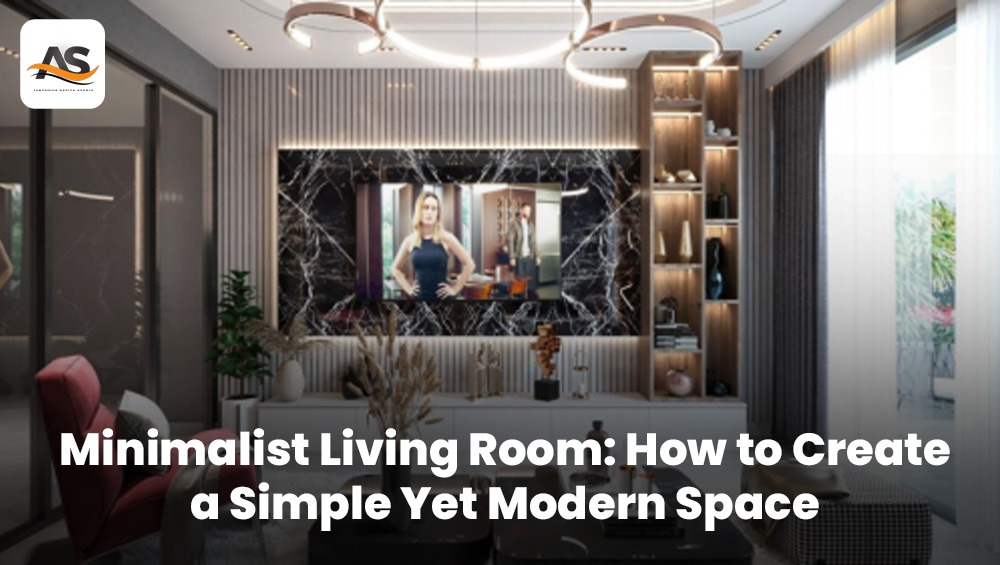Pune and the Pimpri-Chinchwad Municipal Corporation (PCMC) area are rapidly evolving, with a growing number of residents seeking homes that reflect their fast-paced yet balanced lifestyle. In this urban scenario, minimalist living rooms have become increasingly popular.
In recent years, minimalist living rooms have gained massive popularity because they perfectly match the demands of a modern lifestyle: less clutter, low maintenance, and a calming atmosphere. As an experienced interior design studio, we’ve seen clients shift from over-decorated spaces to cleaner, smarter, and more functional living rooms that still feel warm and inviting.
What is a Minimalist Living Room?
A minimalist living room is designed around the idea that less is more. It’s not about having an empty space, but about making every element purposeful.
Key features include:
- Uncluttered Space – Every item has a defined place and function.
- Neutral Tones – Shades like white, beige, and grey dominate, creating a calm backdrop.
- Functional Furniture – Pieces that are both practical and stylish.
How It Differs from Other Styles:
Unlike maximalist or eclectic styles, minimalism avoids excessive patterns, heavy ornamentation, or unnecessary layering. It focuses on clean lines, open layouts, and carefully selected décor, making the room feel breathable and harmonious.
Benefits of a Minimalist Living Room
Designing your living room with a minimalist approach offers more than just visual appeal—it improves how you feel and live in the space.
- Stress-Free Environment
There has been chaos, which has increased stress levels. A minimum of distractions creates a peaceful atmosphere where your thoughts can relax.
- Easy Cleaning & Maintenance
With low decorative objects and simple furniture, dusting, vacuuming, and organizing take quite a short time.
- Makes Space Look Bigger
Minimalist layouts often maximize the open space, making small apartments even larger and airier.
- Timeless Style
Unlike trends that fade rapidly, minimum designs last for the year following the relevant year.
Core Elements of Minimalist Living Room Design
When our interior design studio works on minimalist living room ideas, we focus on these essential elements:
1. Neutral Color Palette
Colors such as white, beige, tan, and soft gray are foundations. They create a cool background and allow furniture and texture to stand out naturally.
2. Simple Yet Functional Furniture
Minimumism is not uncomfortable. Choose pieces that are ergonomic, multicultural, and match the space conditions.
3. Open Space & Natural Light
Avoid blocking windows with heavy curtains or large furniture. Provide natural flood to increase openness.
4. Limited but Meaningful Décor
Each decorative object should serve a purpose – either functional or emotional. A simple statement art or even a coffee table can define the entire room.
Step-by-Step Guide to Designing Your Minimalist Living Room
Step 1: Declutter Your Space
Remove all non-essential goods. Only store the pieces you use regularly or that actually give value to the aesthetics of the room.
Step 2: Choose a Soft and Muted Color Scheme
Stick to 2–3 base colors. Add depth using textures like linen cushions, wool rugs, or wooden side tables.
Step 3: Pick Multi-Functional Furniture
Think of a sofa bed, a TV console with a coffee table, or hidden storage.
Step 4: Use Minimal Décor with a Personal Touch
Instead of many small objects, choose one or two pieces of pronunciation – a large plant, a single abstract painting, or a unique light fixture.
Step 5: Focus on Lighting
Perform your light with a mixture of natural light, floor lamps, and LED-led sealing lights for a comfortable, yet bright room.
Common Mistakes to Avoid
Even with the best minimalist living room ideas, these mistakes can make your space feel incomplete or uncomfortable:
- Over-Decorating – dependence on adding all the elements defeats the purpose of minimalism.
- Choosing Uncomfortable Furniture – minimal design should not only be photogenic but also live.
- Ignoring Storage Solutions – Without smart storage, clutter will creep back in.
Budget-Friendly Tips for a Minimalist Living Room
Minimalism doesn’t have to mean expensive. Here’s how to achieve the look affordably:
- DIY Décor Ideas –paint your wall art or reproduce the old photo frame.
- Thrift Store Finds – Look for high-quality second-hand furniture with clean lines.
- Repurposing Old Furniture – Sand, paint, and reupholster existing pieces to fit the minimalist style.
Why Work with an AS Innterior Design Studio?
While many minimum room ideas can be used on their own, an interior design studio provides professional skills to adapt space, choose the right material, and create a layout that reflects both style and comfort. Professionals also help you balance minimality with heat, and make sure it is not sterile to invite the space.
Visit Page : Residential interior design services
Minimalism is not about removing personality from your living room—it’s about removing what’s unnecessary to highlight what truly matters.
You can create a living room that seems huge, calm, and timeless by embracing neutral tones, functional furniture, open space, and intentional decoration.
Whether you start fresh or change your existing place, remember: Quality is more important than life. And with guidance from a skilled interior design studio, the minimum room can be a sanctuary for style and peace.
Checkout Our Social Media : Instagram
FAQ
-
What is the main concept of minimalism?
The main concept of minimalism is living with only essential and meaningful items to create simplicity and clarity.
-
Why is minimalist interior design so popular?
Minimalist interior design is popular because it creates calm, clutter-free spaces that are easy to maintain and visually appealing.
-
What are the disadvantages of minimalist design?
Some disadvantages of minimalist design include feeling too sparse or cold, limited storage options if not planned well, and the risk of the space looking impersonal or lacking character.
-
How to make an apartment more minimalist?
To make an apartment more minimalist, start by decluttering and keeping only essential, functional items. Use neutral colors, multipurpose furniture, and smart storage solutions to maximize space and maintain simplicity.
-
What is a relaxing color for a living room?
Soft neutrals like beige, light grey, and pastel blues are relaxing colors ideal for a living room.

